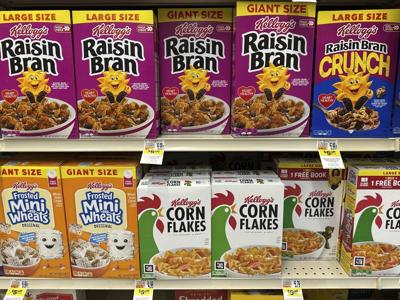Breakfast cereal could use a lucky charm.
U.S. sales of the colorfully packaged morning staple have been in , a trend back in the spotlight with news that Italian confectioner Ferrero Group WK Kellogg, maker of Corn Flakes, Froot Loops, Rice Krispies and other familiar brands.
Except for a brief period during the coronavirus pandemic, when many workers were home and had time to sit down with a bowl of cereal and milk, sales of cold cereal have steadily fallen for at least 25 years, experts say.
In the 52 weeks ending July 3, 2021, Americans bought nearly 2.5 billion boxes of cereal, according to market research company Nielsen IQ. In the same period this year, the number was down more than 13% to 2.1 billion.
Cereal has been struggling for multiple reasons. The rise of more portable options like Nutri-Grain bars and Clif Bars ŌĆō which both went on sale in the early 1990s ŌĆō made it easier for consumers to grab breakfast on the go.
Concerns about food processing and have also dimmed some consumersŌĆÖ enthusiasm for cereals. One cup of contains 24% of a consumerŌĆÖs daily recommended intake of sugar, for example.
ŌĆ£Cereal finds it really hard to get out from underneath that,ŌĆØ said Tom Rees, global insight manager for staple foods at the consulting company Euromonitor. ŌĆ£It can’t escape the fact that it doesn’t look like a natural food. You have to create it and form it.ŌĆØ
Rees noted that for decades, cereal manufacturers focused on to build cereal’s health credentials. But consumers now are looking for simplified ingredient lists.
ŌĆö like the petroleum-based colors that brighten Froot Loops ŌĆö have also come under fire. Last fall, outside WK Kellogg’s Battle Creek, Michigan, headquarters demanding that it remove artificial dyes from its cereals. Kellogg and General Mills ŌĆö another major U.S. cereal maker ŌĆö have since pledged to .
Add to that, consumers are expanding their idea of what breakfast can be. Yogurt and shakes have replaced the traditional bacon and eggs. Kenton Barello, a vice president at the market research firm YouGov, said his polling shows that Generation Z consumers, who were born between 1997 and 2007, eat more vegetables for breakfast than other generations.
Barello said YouGovŌĆÖs polling also shows that members of Gen Z are less likely to eat breakfast but still buy ready-to-eat cereal, suggesting theyŌĆÖre eating it as a snack or for other meals.
ŌĆ£With younger generations, there are differences in their relationship with food and these eating moments,ŌĆØ Barello said. ŌĆ£They are going about breakfast in a different way than Millennials, Gen X and Baby Boomers.ŌĆØ
Cereal’s struggles are part of what led to the . In 2023, the century-old company that put Battle Creek, Michigan, on the map split into two companies. Kellanova took popular snack brands like Cheez-Its, Pringles and Pop-Tarts as well as international cereals, and made cereals for the U.S., Canada and the Caribbean.
In 2024, M&M’s maker Mars Inc. announced a plan to buy Kellanova for more than $30 billion. That plan has cleared U.S. regulators but is still awaiting regulatory approval in Europe. WK Kellogg was left to try to rejuvenate the cereal business.
The sale of WK Kellogg to Ferrero doesn’t mean supermarket cereal aisles are at risk of extinction. Packaged food companies have options for turning around their soggy cereal sales, Rees said. He thinks Kellogg’s Mashups line, which mixed brands like Frosted Flakes and Froot Loops into one box, appeal to younger consumers, who tend to like interesting flavor combinations.
The market may also have a fragmented future, according to Rees. Companies may have to accept that younger buyers want a sweet-and-spicy cereal while older buyers might want a Keto-friendly option.
ŌĆ£The future might be realizing that the era of ŌĆśThis brand will serve everybodyŌĆÖ isn’t going to happen,ŌĆØ Rees said.
Julia Mills, a food analyst with the consulting company Mintel, thinks the shrinking population of children in the U.S. gives cereal makers the opportunity to shift to more sophisticated flavors and packaging. Cereal could be positioned as a fancy topping for yogurt, for example, or a fiber-rich food that can improve gut health.
Some niche cereal brands, like high-fiber Poop Like a Champion cereal and high-protein, zero-sugar Magic Spoon, are already doing that. But legacy brands say they shouldn’t be counted out.
Jeffrey Harmening, the chairman and chief executive officer of Cheerios maker General Mills, said his company considered trying to acquire Magic Spoon. Instead, it made high-protein versions of Cheerios, which now outsells Magic Spoon.
ŌĆ£The key to longer term is, honestly, is giving consumers more of what they want,ŌĆØ Harmening said during a conference call with investors in March.


































